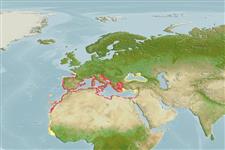>
Blenniiformes (Blennies) >
Blenniidae (Combtooth blennies) > Salariinae
Etymology: Parablennius: Greek, para = the side of + Greek, blennios = mucus (Ref. 45335).
Environment: milieu / climate zone / depth range / distribution range
Ecologia
marinhas; estuarina demersal; intervalo de profundidade 3 - 15 m (Ref. 5981). Subtropical; 47°N - 9°N, 19°W - 42°E
Eastern Atlantic: coast of Portugal, Spain and Morocco south to Guinea. Also in all parts of the Mediterranean (except Syria, Lebanon, Israel and Egypt), in the Sea of Marmara and the Black Sea, and Canary Islands (Ref. 5981).
Tamanho / Peso / Idade
Maturity: Lm ? range ? - ? cm
Max length : 15.0 cm TL macho/indeterminado; (Ref. 3397)
Facultative air-breathing in the genus (Ref. 126274); Adults occur over sandy bottoms with boulders and light vegetation. They hide in crevices where the nests are being guarded by the male (Ref. 5981). Oviparous. Eggs are demersal and adhesive (Ref. 205), and are attached to the substrate via a filamentous, adhesive pad or pedestal (Ref. 94114). Larvae are planktonic, often found in shallow, coastal waters (Ref. 94114).
Life cycle and mating behavior
Maturities | Reprodução | Spawnings | Egg(s) | Fecundities | Larvas
Oviparous (Ref. 205). Several females visit the hole to spawn with the resident male which guards the nest (Ref. 5981).
Bath, H., 1990. Blenniidae. p. 905-915. In J.C. Quero, J.C. Hureau, C. Karrer, A. Post and L. Saldanha (eds.) Check-list of the fishes of the eastern tropical Atlantic (CLOFETA). JNICT, Lisbon; SEI, Paris; and UNESCO, Paris. Vol. 2. (Ref. 5298)
Categoria na Lista Vermelha da IUCN (Ref. 130435)
Ameaça para o homem
Harmless
Utilização humana
Pescarias: sem interesse; Aquário: Espécies comerciais
Ferramentas
Relatórios especiais
Descarregue XML
Fontes da internet
Estimates based on models
Preferred temperature (Ref.
123201): 16.1 - 21.7, mean 19.2 °C (based on 643 cells).
Phylogenetic diversity index (Ref.
82804): PD
50 = 0.5000 [Uniqueness, from 0.5 = low to 2.0 = high].
Bayesian length-weight: a=0.00832 (0.00475 - 0.01456), b=2.92 (2.77 - 3.07), in cm total length, based on LWR estimates for this species & Genus-body shape (Ref.
93245).
Nível Trófico (Ref.
69278): 3.3 ±0.3 se; based on diet studies.
Resiliência (Ref.
120179): Elevada, tempo mínimo de duplicação da população menor que 15 meses (Preliminary K or Fecundity.).
Fishing Vulnerability (Ref.
59153): Low vulnerability (10 of 100).
Nutrients (Ref.
124155): Calcium = 115 [19, 351] mg/100g; Iron = 1.38 [0.53, 4.36] mg/100g; Protein = 4.03 [0.31, 7.75] %; Omega3 = 0.443 [0.188, 1.034] g/100g; Selenium = 9.83 [2.13, 28.31] μg/100g; VitaminA = 21.6 [8.6, 54.4] μg/100g; Zinc = 1.25 [0.60, 2.47] mg/100g (wet weight);
